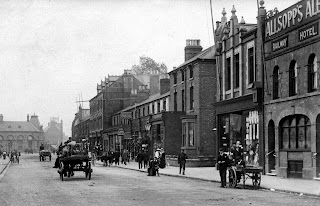Resuming our tour of Goole, here's the Clock Tower and Market Place.
Another old view of the town from outside the Railway Hotel.
It's 1926 and the flags are out, but not for that little Chevrolet bus.
On the edge of the town centre, Pasture Road and Hook Road.
Turning to the docks, a view from the water tower.
The water tower is on the right. The two buildings became known as the "Salt & Pepper Pots".
Coal from the Yorkshire collieries was transported by canal to Goole, in trains of "Tom Puddings".
Each "Tom Pudding" was hoisted out of the water for transfer to sea going vessels. This contraption is what did it.
Goole Barge Dock, circa 1890.
No coal these days, but Goole still handles commercial traffic.
The SS Blyth leaves Goole Docks via the Ocean Lock, which gives access to the River Ouse.
The exit from the docks in 1994.
The Dutch River, Goole Docks and Sandhall Point, Kilpin, from the east, 1930.
Goole Docks were still rail served in 1980.
In 1982, Goole Goods Junction signal box was operational, but soon closed.
Beyond the docks was Goole loco shed, seen here in LMS times.
Ex Lancashire & Yorkshire Railway 'pugs' were shedded at Goole for shunting the docks.
In the last post we saw a WD 2-8-0 on a railtour at Goole station on 8 October 1966. The locos were later swapped, beside Goole shed, with 42942 taking the train nwards.
Leaving Goole behind, we follow the Ouse around to the village of Swinefleet. The local urchins greet us in 1909.
The Perseverance Bus Company had its depot in Swinefleet.
To the south of Swinefleet was an area of peat bog, known as Goole Fields. A narrow gauge rail system was used to harvest the peat. Here's a group of locals having a day out on it.
In the middle of nowhere was Reedness Junction, a station on the Axholme Joint Railway, where the branch to Fockerby diverged from the line to Haxey Junction. In the later days of the passenger service, a Sentinel steam railcar was used.
Heading towards the River Trent (see the map here) we find the church at Adlingfleet, where the tomb of Sir Francis de Haldenby can be found.
To the south is Garthorpe. Here's a postcard of the High Street.
Garthorpe is contiguous with Fockerby, with its Axholme Joint Railway terminus.
Luddington was served by the Axholme Joint Railway. Here's a view of the village.
The Axholme Joint Railway was originally called the Goole & Marshland Light Railway. Here is a director's special at Eastoft station, on the Fockerby line on 26 June 1901.
Photographed in Eastoft in the mid 1970s was this old Bradford trolleybus, in use as a caravan. It later went to the museum at Sandtoft.
Eastoft is home to a decent pub, the River Don.
That seems like a good place to end this post. The next one will see about to cross the River Trent.



































No comments:
Post a Comment